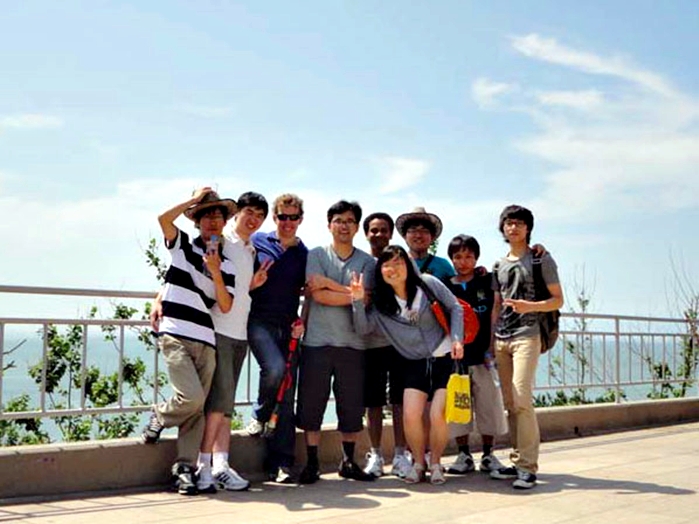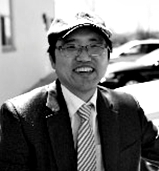이달의 관심논문
이재범 (부산대학교 교수)
-
1. Title
J. Lee, et al., “Small molecule induced self-assembly of Au nanoparticles”Journal of Materials Chemistry, VOL. 21, 16935-16942, Feb 2011.- 논문다운로드: http://pubs.rsc.org/en/Content/ArticleLanding/2011/JM/c0jm04268d
- 교신저자(Corresponding Author): Jaebeom Lee (부산대학교, Pusan National University). E-mail: jaebeom@pusan.ac.kr
- 연구실: (LEE LAB: Light Energy Environment Laboratory): http://www.leelab.re.kr

부산대학교 LEELAB연구원들과 WCU석학교수 Kotov교수(미시간대)와 중국 옌지 워크삽
2. Abstract
Interest in one dimensional assemblies of metallic nanomaterials, particularly Au nanoparticles (NPs), has grown due to the optical properties and various applications of NPs in optoelectronics, biosensors, and nano-electronics. In general, one-dimensional alignments of Au nanostructures have been accomplished by using soft or hard templates, such as polymers, DNA, anodized aluminum oxide or even molecular templates. However, difficulties of nanoscale control and remnant byproducts through unwanted chemical reactions have become a limitation. In this paper, a no-template assembly was successfully carried out to produce one dimensional nanochains of Au NPs through N-ethyl-N′-(dimethylaminopropyl) carbodiimide (EDC) chemistry, where carboxylates on the surface of Au NPs are activated by EDC at room temperature. EDC is a fascinating candidate for nanomaterials assembly due to its easily chemical-activating ability as well as well-known biocompatibility. Physiochemical properties of the nanochains were characterized by TEM, AFM, UV/Vis, and FT-IR spectrophotometers, as well as zeta potential. Molecular dynamics (MD) simulations were also carried out in order to reveal the structuring mechanisms of the chains. Experimental and computational results indicate that the strong interaction between citrate-EDC-citrate and Au NPs was related to van der Waals forces and the Coulomb force of the functional groups, inducing delicate manipulation of the main bonding energy for self-assembly those NPs.
3. 논문 기여사항 (Contributions)
나노분야의 가장 큰 관심거리중 하나는 어떻게 나노물질을 효과적으로 제어할 것인가 입니다. 제어하는 방법은 여러가지가 있겠지만, 크게 두가지로 나눌수 있습니다. 즉, 외부에서 힘(에너지)를 주어 강제로 제어하게 하는 방법과 내부에서 나노입자 자체에서 생긴 아주 작은 에너지를 스스로 제어하게 하는 방법입니다. 자연발생적으로 만들어진 대부분의 물질들, 특히, DNA, 단백질 등과 같은 소규모의 바이오물질들은 이 방법에 의해서 만들어진 것입니다. 바이오에서 얻은 지식을 이용해서 나노입자를 효과적으로 제어하는 방법을 생체모사 자가조립법 (bio-mimic self-assembly)라고 합니다. 본 논문은 나노입자중 가장 많이 사용되는 금나노입자를 분자 한 종을 이용해 막대모양으로 연결하는 방법을 보여주고 있습니다. 단일 금입자가 막대모양으로 연결되면 장파장 (>600nm)에서 매우 우수한 흡광을 일으키는 기이한 분광학적 특징을 보입니다. 이를 이용한 다양한 센서 및 이미징 디바이스의 응용이 가능합니다. 특히, 사용된 분자는 이미 어셈블리에서 많이 사용되고 있고 생물학적 안정성이 입증된 물질을 사용하여, 막대모양의 물질이 in- vivo 바이오 재료로도 사용될 수 있도록 고안하였습니다. 현재 이를 이용한, SERS, Plasmonics, SPR devices의 응용에 대한 다양한 추가실험을 하고 있습니다.
■ 이제범 교수 소개

이제범 교수는 1998년 충남대에서 화학과 학사, 2003년 Robert Gordon University, Aberdeen (Scotland)에서 박사학위를 취득하였고, U. Michigan, Ann Arbor, 화학공학과에서 Post-Doc후, 2007년 부산대학교 나노응용공학과에 부임하였다.
이재범 교수는 나노입자 합성 및 제어, 바이오센서 분야에서 지난 5년동안 70 여편의 국제학술논문을 게재하였고 출간된 논문들은 1,300 여회 인용되었다. 나노입자의 표면플라즈몬공명 현상에 기반을 둔 극초미량 바이오센싱 및 나노초구조체 (nanoscale supramaterials) 합성에 관심을 갖고 있으며, 최근에는 이를 활용한, 수산물 종및 원산지 평가, 결핵환자 진단센서 분야의 기술 발전을 추구하고 있다.